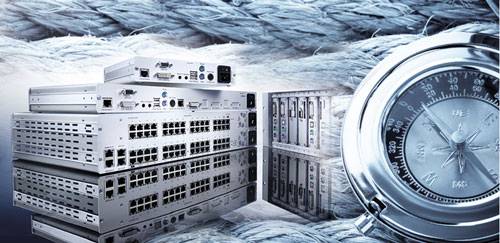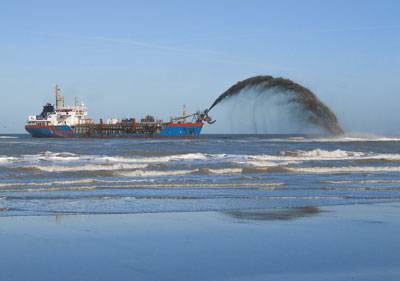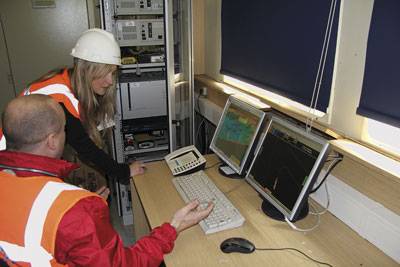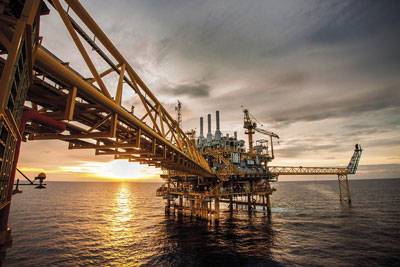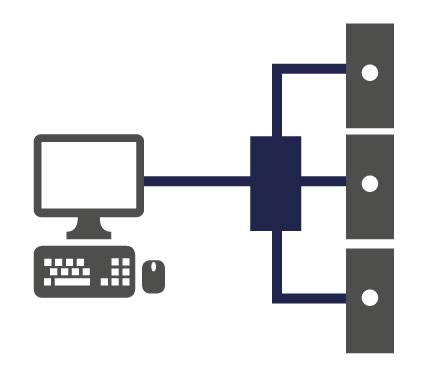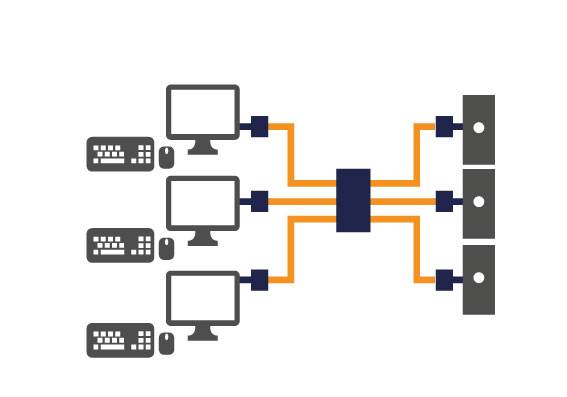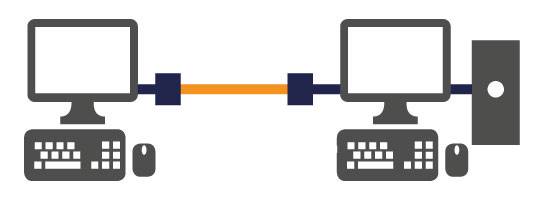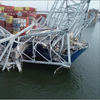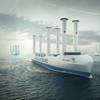KVM in Maritime Use
Special fields of application such as maritime environments pose extreme working conditions for IT devices. A challenge faced by KVM manufacturer Guntermann & Drunck who optimized their products for the use in maritime applications: ship bridges, control rooms, offshore platforms and control of waterways – compliant with IEC 60945.
Applying IT devices under extreme conditions
Strong winds, salty air, waves and vibrations are just some of the strains IT equipment is exposed to when used on water. When the next harbor is many sea miles away, any IT component must be as robust and reliable as possible. Such high demands require complex IT equipment. Complex IT equipment, however, is often applied at the expense of the crew’s ability to carry out their tasks as quickly and effectively as possible. Therefore, the technology running in the background must not distract them from their work. IT components providing intuitive operation are key; IT components such as KVM products from German manufacturer Guntermann & Drunck GmbH.
Security thanks to IEC 60945, Tempest and more
As pioneers for KVM application in maritime environments, Guntermann & Drunck devices are compliant with specification IEC 60945. G&D carefully selected specific products from their portfolio to be tested according to the norm. After the successful test that qualifies navigation and radio communication equipment and systems for the use in maritime applications, G&D KVM products are now ready to be applied in engine rooms, technology rooms and even on ship bridges. Qualifying for the specification includes numerous tests regarding the environment (heat, cold, vibration), security and electromagnetic compatibility (EMC) and meets an international standard. More information about the KVM equipment complying with the specification can be obtained from the manufacturer upon request.
Selected KVM switches from Guntermann & Drunck provide certifications according to the requirements of Tempest, too. With their high standards regarding quality and security, these devices can be used in military applications or in the field of public security.
To prevent failures, G&D devices include redundant components such as power packs guaranteeing smooth operation. Using only high-quality components and applying them far below their maximum load guarantees a long life for every product.
As a special offer to the ship building industry, G&D provides devices with power supplies of 12 or 24 Volt.
Comprehensive preventive monitoring rounds up the KVM security package and goes far beyond the simple extension and switching of computer signals.
KVM equipment can be applied in versatile ways: on ship bridges and technical control rooms, in control rooms that monitor harbors and seaways and on offshore platforms.
Monitoring process on ship bridges and in control rooms
The crew on board monitor multiple processes 24/7. But neither the bridge nor the technical control room provides enough space for sensitive yet noisy, heat-emitting computer equipment. Thanks to KVM, computers can be removed into separate, access-secured server rooms. Robust KVM extender systems bridge the distance between computers and users on the bridge or in the control room. The crew can access the remote computers in realtime without noticing any latency or loss in quality – without any additional software and independently from any network. Via list or hotkey, the crew can operate any computer included in the system and switch its contents to their screen.
But not only the users benefit from their connection to the KVM system. Updates and maintenance work can be carried out directly in the server room without distracting the technical crew from their work. And on top of it, a protected, air-conditioned environment ensures a long life for every product.
Monitoring harbors and seaways in vessel traffic service centers
In Vessel Traffic Service Centers (VTC) and other maritime control rooms, the entire KVM portfolio is used to simplify the tasks of the crew and their IT equipment: KVM extenders, switches and matrix switches. Again, computers are separated from the actual working area and placed in separate server rooms. Thanks to KVM, each workstation still has access to the entire equipment, which provides crystal-clear images on all screens.
During their work, users don't even realize that they operate their computers remotely since they are able to access them without any latency down to BIOS level. That way, information can be displayed on large screens or direct them via touch panel.
Offshore solutions require perspective
As technological leaders of high-end KVM solutions, G&D know about the high demands to safety and operation in the offshore industry. Hence, Guntermann & Drunck provide their devices with various features such as monitoring and SNMP. These monitoring features permanently check the status of G&D devices and the connected peripherals. This makes it easy for the IT staff to react to critical conditions (like increased temperatures, power issues, critical computer statuses, communication errors between interfaces, issues with the redundant system or other critical conditions) before they lead to failures. Even if the display loses the video signal, the Screen-Freeze function freezes the last displayed image and thus prevents disorientation.
Whatever happens in the background?
With the help of KVM, sensitive computer technology is placed in a server room where the devices are air-conditioned and protected from unauthorized access. KVM devices can be easily installed via plug-and-play. To bridge the distance between computers and users, KVM uses the existing cable infrastructure (CAT cables or optical fibers). There are two ways to establish a connection to the computers placed in the server room: either a direct connection with transmitting and receiver modules or via matrix system.
The 1:1 connection over KVM extenders allows users to connect the standard interfaces of their computer (keyboard, video, mouse, RS232, USB, audio) directly to a KVM switch. Infrastructural cables extend the signals of these ports to the receiver placed in the control room or on the bridge. The receiver provides connectors for the users’ monitor and input devices and allows them to start working immediately. A local console at the KVM transmitter allows the IT staff to maintain and to configure the equipment from the server room without having to go to the bridge or to the control room where they would distract the people working there.
A KVM switch helps users access a small amount of different computers from their workstations. Standard cables connect the computer ports to the KVM switch. By pressing a key or using a shortcut, they are able to switch their monitor, keyboard and mouse to the desired computer. The operating systems of the computers don’t play any role since connection cables establish a connection to the external interface and therefore do not require a network.
When using a large amount of computers, a KVM matrix comes into play. Here, standardized computer modules connect the computers to a centralized KVM matrix switch. Their counterparts, the user modules, are installed at the consoles on the bridge or in the control room and provide connectors for any peripheral devices.
Through their connection to the matrix switch, each console has direct access to any computer and therefore to any computer processes. Tasks can be shared and assigned as flexibly as possible. Access to the matrix is managed over individual user profiles.
Innovations, trends and future-oriented technologies
To develop solutions fitting the most diverse environments, G&D put their customers’ requirements first and offer them many services free of charge, including loaned equipment, consulting and planning of complex KVM installations, 36 months of warranty instead of the legally required 24 months, personal technical customer support instead of being placed on hold and more.
The team of Guntermann & Drunck GmbH look forward to meeting visitors of SMM at stand 415 in hall B6. Here, interesting parties can discuss individual ideas, projects and their challenges directly with the team of KVM experts. Numerous references prove the confidence in the products of the German manufacturer.
Among G&D’s long-time customers are organizations from air, ground and ship traffic control such as Deutsche Flugsicherung GmbH, EUROCONTROL – European Organization for the Safety of Air Navigation, the German federal Navy, Imtech N.V., the water management centre of the Netherlands, Van Oord n.V. and many more.
gdsys.de










